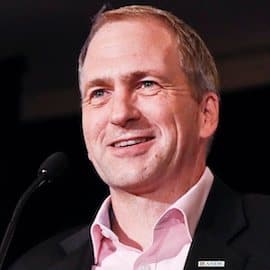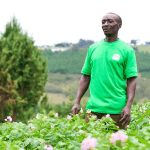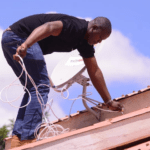Charting the Next Decade in the Global Small and Growing Business Sector: A Q&A with ANDE Executive Director Randall Kempner
In September 2010, the first week I was on the job as editor of NextBillion, I hopped a plane to New York to attend the annual meeting of the Aspen Network for Development Entrepreneurs. I was somewhat overwhelmed.
Not only was I writing about a completely new sector (I had been a reporter covering the auto industry just a few weeks before), the crowd at ANDE were an intensely passionate bunch. They graciously hit this newcomer with a mountain of interesting facts, dynamic stories and sometimes intractable quandaries. The conference was definitely a “drinking from the firehose” moment. But the contacts I made during those few days helped shape my understanding of the challenges faced by small and growing businesses worldwide – and by their investors and the greater global development community – both in 2010 and over the years to come. Many of the people with whom I exchanged business cards were key future contributors to NextBillion, often setting the terms of the discussions and debates we hosted around a host of different subjects – from best practices in setting up impactful business incubators, to new models for capital investment and women-owned businesses. It was clear why my boss sent me there.
Then, as now, ANDE was led by Executive Director Randall Kempner. In 2010, Kempner had then just started encouraging members to use the term “small and growing businesses,” (SGBs) at the annual meeting, to distinguish them from perhaps more static SMEs. (He explains why below.) As the organization celebrates its 10-year anniversary with about 300 members representing some 150 countries, I asked Kempner where ANDE is going, how it plans to get there, and what that will ultimately mean for entrepreneurs around the world looking to lead more profitably empowered lives.
Scott Anderson: As you reflect on the last decade, what are the biggest changes you at ANDE have observed when it comes to the overall cultivation of SGBs in low-resource settings as a focus in development?

Randall Kempner
Randall Kempner: Well, we can start with an obvious one. The term Small and Growing Businesses (SGBs) is actually being used in the development field, and we can credibly say that there is a recognized “SGB sector.” This change is significant because it represents an understanding of the importance of supporting growth-oriented small businesses in driving social and environmental outcomes. Leading funders like USAID, Ford Foundation, Argidius Foundation, Visa Foundation and others are developing new programs aimed specifically at SGBs and the organizations that serve them.
With the support of these funders and others, ANDE’s 300 members have also been innovating on how to support SGBs over the past decade. On the investment side, we’ve seen a growing recognition that traditional private equity fund structures and deal terms don’t work that well in the SGB space. Rather, there has been an increased focus on royalty-based investment vehicles that preserve entrepreneur-ownership of the firm while ensuring faster financial return to investors. On the capacity development side, we’ve seen the proliferation of emerging market-based business accelerators trying a variety of models to help SGBs in low-resource settings. And the Global Accelerator Learning Initiative is now providing insights about which types of programs work best.
SA: You recently announced an updated strategy that focuses on gender, the environment and job creation as the key themes for the organization. Why was this necessary, and why did you choose those particular areas?
RK: The updated ANDE strategy has been developed in response to the needs of the sector in addition to ANDE’s core competencies. ANDE will build on its strengths as the leading advocate for the SGB sector, and as the developer of high-quality programming that improves the effectiveness of SGB sector organizations.
We chose to focus on the challenges of talent development, SGB finance and impact management because ANDE believes them to be significant ongoing issues that are facing SGBs and SGB intermediaries. ANDE has been working in these areas for a decade now, and we believe that they are especially important given the present level of development of the SGB sector.
We also felt as if ANDE could increase its impact by focusing on specific United Nations Sustainable Development Goals (SDGs) on which SGBs could make the most impact. Based on our own research, and input from our member organizations, we landed on SDG 8, SDG 5, and an amalgam of environmentally focused SDGs (6, 7 and 13).
The most obvious area of impact for ANDE is related to creating decent employment opportunities (SDG 8). The first way that most SGBs will drive prosperity is by creating jobs. In the face of the youth unemployment bulge in most emerging markets, SGBs offer great potential to provide employment and reduce social unrest.
Throughout emerging markets (and the developed world, for that matter), women consistently face deeper challenges than men in starting, funding and growing businesses. However, many studies show that women are as good as, or better than, men at being businesspeople, and they are more likely to reinvest their earnings in long-term assets like education, health care and housing for their families. Gender inequality is a steep tax on global prosperity.
Women-led SGBs represent an opportunity to create jobs, change attitudes toward women in power, and create more welcoming environments for female workers. However, too few ANDE members have an explicit gender strategy, either for themselves or for their clients/portfolio companies. And too few funders embrace the need to increase investment in women-led or managed SGBs. ANDE plans to build on its already strong set of programming in this space.
Humanity is facing an unprecedented increase in greenhouse gases that is leading to accelerated climate change. We are seeing higher temperatures, more intense weather events and sea level rise. Many scientists believe human civilization is facing an existential threat. And most recognize that developing world nations are the most likely to suffer due to increased environmental adversity. ANDE believes that SGBs can be an important tool in mitigating, or at least not exacerbating, this dangerous trend.
New “climate smart” business opportunities are arising to help communities reduce carbon emissions and adapt to new environmental conditions. SGBs can help invent and distribute technologies focused on water preservation, efficient sanitation and clean energy, just to name a few.
SA: On a practical level, does this strategic shift have any impact on which organizations ANDE will admit as members? That is, if an organization isn’t working in one of those broad areas but is still engaged with SGBs, will they still be invited to join ANDE?
RK: The refreshed strategy will not have an impact on which organizations ANDE will admit as members. Our big tent will remain big. We continue to believe that SGBs are relevant to all 17 SDGs. And while we will have more of a focus on some SDGs rather than others, organizations that do not share one of these focus areas will still benefit from the extensive set of member services we offer, including our annual conference, regional chapter convenings, training programs, access to funding opportunities, and bespoke connections to sector organizations.
SA: A tangible example of the new strategy seems to be a partnership with USAID and Visa to launch the ANDE Gender Equality Initiative and the Advancing Women’s Empowerment Fund, which you say will distribute $1 million in catalyst funds to entrepreneurial support organizations in South and Southeast Asia. Can you tell readers about the goals behind this particular fund, and is this something ANDE hopes to emulate in future projects?
RK: The goal of the broader ANDE Gender Equality Initiative (AGEI) is to cultivate entrepreneurial ecosystems in emerging markets that are responsive to the specific challenges faced by women, including gender bias and institutional exclusion. The AGEI will work to strengthen entrepreneurial support organizations so they can build their own capacity to apply an appropriate gender lens to policy, investment and capacity development efforts. The ultimate aim is to massively increase the amount and quality of the support to women-led SGBs, and SGBs that provide products and services that help women and girls.
The Advancing Women’s Empowerment Fund is more specifically targeted at addressing the access to finance gap for women-led businesses. With plans to distribute over US $1 million in funding over two years to entrepreneurial support organizations in South and Southeast Asia, the fund will identify the best strategies to drive investment capital into the hands of women entrepreneurs in emerging markets.
ANDE is already developing other similarly structured challenge or catalyst funds, and indeed we have a few under development that we hope to officially launch within the next 3-6 months.
SA: According to the latest ANDE member survey, a lack of access to capital was the most cited challenge for both SGB support organizations and the SGBs they worked with (27%). Lack of access to talent (18%), markets (14%), and difficult government policy and regulations (14%) were the other areas. How does ANDE primarily work to increase the flow of capital to SGBs? For instance, should the top priority be building out a support ecosystem, or working with financial institutes? How do you make that determination country-to-country?
RK: ANDE believes the ideal scenario to build entrepreneurial ecosystems is to address all of the issues listed above in a comprehensive, collaborative way. You could have all the money in the world, and it wouldn’t matter if you didn’t have talented people running SGBs with access to both local and global markets. And you could have amazing entrepreneurs who would go nowhere if they faced capital and regulatory constraints. So we’ve developed a tool for assessing entrepreneurial ecosystems, and a perspective on how to best organize collective impact efforts to cultivate ecosystems at the metropolitan area level.
Happily, in early 2019 we completed the first phase of the Uganda Entrepreneurial Ecosystem Initiative, which provided ecosystem assessments of the Gulu and Kampala regions. Now, in 2020, we are set to implement the second phase that will leverage the insights generated in phase one to build community coalitions to address key ecosystem challenges in a coordinated way.
SA: ANDE now has eight regional offices. Can you talk about their role in delivering on the new strategy? Do you envision adding even more offices in the next decade?
RK: ANDE’s regional chapters are absolutely critical to ANDE’s past, present and future. Having full-time staff in eight chapters (three in Africa, three in Latin America, two in Asia) allows us to deliver specific programming and help link our members to each other, and to global sector leaders. Under the new strategy, the chapters will play an increasingly important role in developing and delivering programs related to our global areas of focus, customizing our work to the needs of the local markets.
We do not plan to add additional chapters in the next few years, but we may add additional staff to new countries within our chapter areas. For example, it is likely we’ll have new full-time staff in Francophone West Africa, as well as another country in Southeast Asia outside of our Bangkok hub.
SA: What gives you encouragement that ANDE is moving the needle on SGB growth in emerging market countries, and what’s your vision for the next 10 years?
RK: Our growth as an organization and as a sector encourages me. ANDE has grown from 34 founding members to nearly 300 today. There are clearly more entrepreneurial support organizations forming and focusing on the SGB sector throughout developing economies. Each year we are tracking the launch of at least 50 new investment facilities focused on SGBs in emerging markets, and our research shows that these funds have collectively raised at least $37 billion over the past decade. Finally, we have seen a significant uptick in OECD donor support to entrepreneurship programs.
We know that the sector and ANDE have much more work to do, though. Over the next 10 years, we hope to make a real dent in the capital access gap (which is in the trillions, not billions) for SGBs, to see marked increases in the number of successful women entrepreneurs in emerging markets, and to spur SGBs to become part of the response to the climate crisis. Attaining the sustainable development goals will not be easy – but ANDE and the broader SGB sector are better positioned than ever to contribute to long-term global prosperity.
Scott Anderson is a contributing editor at NextBillion.
Photo: ANDE staff celebrating their 10th anniversary. Photo courtesy of ANDE.
- Categories
- Finance, Impact Assessment, Investing, Social Enterprise



